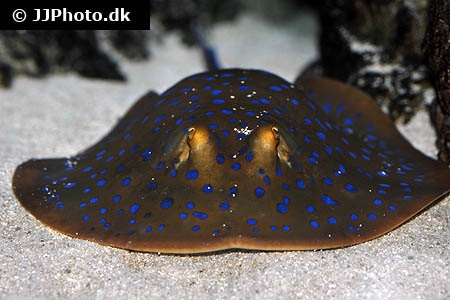Taeniura lymna
| Latin name | Taeniura lymna |
|---|---|
| Local name | Ribbontail stingray |
| Family | Dasyatidae - Taeniura |
| Origin | East Indian Ocean, West Indian Ocean, Japan, The Red Sea, Indonesia, Central/West Pacific |
| Max length | 35 cm (13.8") |
| Minimum volume |
3000 l (792 gal) |
|---|---|
| Hardiness |
Delicate |
| Suitable for aquarium |
Experience, preparation and extra care required |
| Reef safe |
Reef safe with caution |
| Aggressiveness | Unknown |
| Recommended |
Fish Larger crustaceans (Shrimp, crabs...) Other invertebrates Small crustaceans (Krill, mysis, artemia...) |
|---|
This species is endangered.
This species is hard to keep alive and thriving.
This species poses a threat towards shrimps and crabs etc., which are relatively small.
This species is highly venomous and this venom can, under certain circumstances, be fatal.
In case of poisoning, it is vital to have as much information as possible regarding the species/poison. Have telephone number for the poison hotline close to the aquarium.
Since people can have different reactions to poisons, take precautions necessary to ensure your safety and that of your surroundings.
This species must be fed with an appropriately varied diet.
This species is very sensitive during transportation and acclimatizing into the aquarium.
This species thrives best if there is sufficient sand into which it can dig itself in.
Should be fed with a varying mix of small pieces of squid, fish, mussel, crustacean and krill.
It can be difficult to estimate how big an aquarium these fish require, but it goes without saying that the sand area must be very big and sufficiently deep for the fish to bury into.
Stingrays will thrive best in an aquarium which is mainly dedicated to them.
They need a large sandy area, which therefore means a very large tank.
Adam Blundell. Saltwater Ray Husbandry - Wet Web Media - (English)




